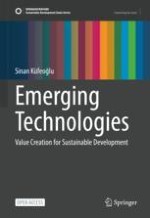Open Access 2022 | Open Access | Buch

Emerging Technologies
Value Creation for Sustainable Development
verfasst von: Sinan Küfeoğlu
Verlag: Springer International Publishing
Buchreihe : Sustainable Development Goals Series
Open Access 2022 | Open Access | Buch

verfasst von: Sinan Küfeoğlu
Verlag: Springer International Publishing
Buchreihe : Sustainable Development Goals Series
This monograph investigates a multitude of emerging technologies including 3D printing, 5G, blockchain, and many more to assess their potential for use to further humanity’s shared goal of sustainable development. Through case studies detailing how these technologies are already being used at companies worldwide, author Sinan Küfeoğlu explores how emerging technologies can be used to enhance progress toward each of the seventeen United Nations Sustainable Development Goals and to guarantee economic growth even in the face of challenges such as climate change.
To assemble this book, the author explored the business models of 650 companies in order to demonstrate how innovations can be converted into value to support sustainable development. To ensure practical application, only technologies currently on the market and in use actual companies were investigated. This volume will be of great use to academics, policymakers, innovators at the forefront of green business, and anyone else who is interested in novel and innovative business models and how they could help to achieve the Sustainable Development Goals.
This is an open access book.